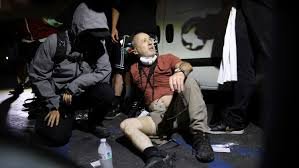What started as a relatively peaceful protest in downtown Los Angeles erupted into chaos last night when a British freelance photographer was reported to have been shot in the face with a plastic bullet fired by police. The incident has raised serious questions regarding press freedoms, tactics for controlling crowds, and where the line lies between maintaining order and excessive force, as it occurred amid heightened tensions between protesters and law enforcement.
The photographer was identified as James R. Clarke, a 34-year-old London-based freelance photojournalist working for various international organizations. He was covering a protest promoted in support of social justice reform and police accountability. According to witnesses and initial reports, Clarke was easily identifiable as a member of the press; he was wearing a “PRESS” vest and was holding up his camera when he was shot.
“I had just raised my lens to get a wide shot of the crowd and the police line,” Clarke told reporters from his hospital bed, his left eye swollen shut and cheek heavily bruised. “The next thing I knew, I felt a sharp pain, and I hit the ground.”
Clarke was quickly attended to by street medics and later taken to a local hospital, where doctors confirmed that the projectile had been a kinetic impact round, commonly referred to as a plastic bullet. Although his injuries are not life-threatening, doctors are concerned about possible injury to his eyesight.
Shocking Strike Caught on Playback
The moment of impact was recorded on video by another freelance reporter at the scene and rapidly spread across social media platforms, which sparked outrage. The footage clearly shows Clarke standing still, camera raised, when a shot is fired in his direction.
“It’s horrifying,” said LA-based activist Maria Delgado. “We were told these weapons are for dispersing violent crowds, not journalists doing their job.”
Multiple organizations, including the National Press Photographers Association (NPPA) and the Committee to Protect Journalists (CPJ), have issued statements condemning the use of force against media personnel.
“This is not an isolated incident,” said CPJ’s U.S. program coordinator, Katherine Jacobsen. “We are witnessing an alarming trend in the United States where journalists are increasingly being targeted while covering protests. It must stop.”
Police Response Under Scrutiny
The Los Angeles Police Department (LAPD) issued a brief statement acknowledging the incident, saying it was “under internal review” and that officers had been instructed to “follow crowd management protocols” to minimize harm. However, officials also stated that protestors were “aggressive” and that “officers responded with appropriate non-lethal measures.”
That justification hasn’t sat well with civil rights groups. “There is no justification for shooting at a marked journalist who posed no threat,” said ACLU Southern California Legal Director Ahilan Arulanantham. “This is a blatant violation of constitutional rights.”
A Pattern of Suppression
This latest incident adds to a growing list of journalists injured while covering protests in the U.S., many of them by rubber bullets, pepper spray, or tear gas. A 2020 CPJ report noted over 400 incidents of aggression against members of the press during civil unrest following the George Floyd protests.
British officials are also paying close attention. A spokesperson from the UK Foreign Office said they are “deeply concerned” and are seeking more information from U.S. authorities.
“We expect our citizens, particularly journalists, to be treated with respect and safety while doing their job,” the spokesperson said.
Despite his injuries, Clarke remains steadfast in his commitment to journalism. “I don’t blame the American people,” he said. “What’s happening here is a struggle for justice and truth—and it’s our job as journalists to show the world what that looks like, even when it’s dangerous.”
As Clarke prepares for further treatment and a potential flight home to London, questions linger in the streets of LA: How much force is too much? And when did reporting the news become a risk to one’s life?
The answers, it seems, remain blurred—much like Clarke’s injured eye, staring into the harsh flash of a camera that now captures not just protest, but peril.
FOR MORE UPDATES, VISIT QUESTEURO

More Stories
Cultural Divide Over Ice in Water Highlights Transatlantic Differences
France Criticizes US-EU Trade Deal Amid Tensions Over Tariffs
Transatlantic Ice Debate Highlights Cultural Differences in Beverage Service